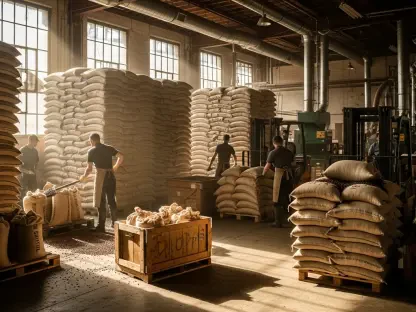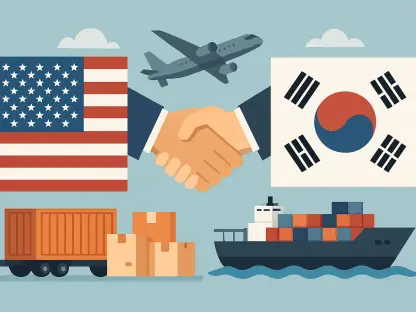The landscape of international trade has shifted dramatically with the recent executive order exempting over 200 agricultural products from reciprocal tariffs in the United States. This decision, impacting goods like coffee, tropical fruits, and beef, comes amid a backdrop of protectionist policies aimed at balancing trade deficits. How does such a pivot affect supply chains, consumer prices, and diplomatic ties? This roundup gathers insights from various industry stakeholders, trade experts, and policy analysts to unpack the motivations behind these exemptions and their broader implications. The purpose is to present a multifaceted view on this significant policy change, comparing differing opinions on its economic and strategic impacts.
Diving into the Policy Shift: Context and Significance
The exemptions mark a notable departure from the initial tariff strategy rolled out earlier this year, which imposed a baseline 10% global tariff on imports to protect domestic industries. Covering 237 classifications across eleven agricultural categories, the policy adjustment addresses products that are challenging to source within the US due to geographic and climatic constraints. Industry groups have hailed this as a pragmatic move, while some analysts question whether it dilutes the original intent of leveling trade imbalances.
This shift emerges from a complex interplay of economic necessities and international negotiations. With tariffs previously inflating costs on essential imports, the decision to lift them reflects a response to mounting pressure from both domestic stakeholders and foreign partners. The retroactive application, effective from mid-November, further underscores an intent to mitigate past financial burdens on importers through refund mechanisms.
A critical lens on this policy reveals deeper questions about sustainability and trade philosophy. While immediate relief is evident, the long-term effects on domestic agricultural sectors remain under scrutiny. This roundup seeks to explore these tensions by synthesizing diverse perspectives on what this exemption means for the US economy and its global standing.
Voices from the Field: Industry and Expert Opinions
Supply Chain Impacts and Consumer Price Concerns
Trade associations have been vocal about the necessity of these exemptions for maintaining supply chain stability. Representatives from consumer goods sectors argue that tariffs on irreplaceable imports like bananas and fruit juices drive up retail costs, disproportionately affecting lower-income households. Their stance emphasizes the need for policies that prioritize affordability over blanket protectionism.
On the flip side, some economic analysts caution that while consumer prices may stabilize in the short term, over-reliance on foreign supply could pose risks during global disruptions. They point to the delicate balance between ensuring access to tropical goods and fostering domestic agricultural innovation, suggesting that exemptions might delay necessary investments in alternative sourcing strategies.
A third perspective comes from logistics experts who highlight the operational relief these exemptions provide. With tariffs lifted, importers can streamline customs processes and reduce warehousing costs tied to delayed shipments. This operational efficiency, they argue, indirectly benefits consumers through faster delivery of perishable goods, though it does little to address underlying trade dependency issues.
Trade Diplomacy and Strategic Agreements
Policy analysts focusing on international relations view the exemptions as a direct outcome of targeted trade diplomacy with countries like Guatemala, Vietnam, and Thailand. These nations, key exporters of products such as bananas and coconut water, have secured tariff-free access through recent agreements, reflecting a strategic use of trade policy to strengthen bilateral ties.
However, some foreign policy commentators express concern over the potential for such deals to create uneven dependencies. They argue that while diplomatic wins are evident, the US risks ceding leverage in future negotiations by prioritizing short-term supply needs over long-term self-reliance. This critique raises questions about whether such exemptions could lock in reliance on specific trade partners.
A contrasting opinion from trade negotiators suggests that these agreements are a stepping stone toward broader economic collaboration. By aligning tariff policies with diplomatic goals, the US can build trust with exporting nations, potentially paving the way for reciprocal concessions in other sectors. This perspective frames the exemptions as a calculated move within a larger geopolitical strategy.
Industry Advocacy’s Role in Shaping Policy
Lobbying efforts by major trade groups have undeniably influenced this policy shift, with organizations representing food importers pushing hard for relief on essential goods. Their argument centers on the reality that certain agricultural products cannot be grown domestically, making tariffs an unnecessary burden that ripples through the supply chain to end consumers.
Yet, some policy watchdogs question whether industry influence might overshadow broader public interests. They suggest that while large importers benefit from reduced costs, smaller domestic farmers could face increased competition without sufficient protective measures. This viewpoint calls for a closer examination of who truly gains from such policy adjustments.
Another angle comes from regional business coalitions in agricultural hubs, which see the exemptions as a mixed blessing. While importers in these areas welcome lower costs, local producers worry about market saturation from cheaper foreign goods. Their input underscores a geographic disparity in how the policy’s benefits and drawbacks are distributed across the nation.
Retroactive Relief and Administrative Adaptability
The retroactive nature of the exemptions has drawn attention from trade compliance specialists, who praise the flexibility it offers businesses. By allowing refunds for tariffs paid prior to the effective date in mid-November, the policy acknowledges past financial strain and provides a mechanism for recovery, boosting confidence among importers.
Differing views emerge from fiscal policy analysts who debate the precedent this sets for future trade governance. Some see it as a sign of adaptability, indicating a willingness to correct course based on real-world outcomes. Others warn that frequent retroactive adjustments could create uncertainty, making it harder for businesses to plan long-term investments.
A practical perspective from customs brokers focuses on the implementation challenges of processing refunds. While the intent behind retroactivity is clear, logistical hurdles in verifying past payments and ensuring equitable distribution of relief could temper the policy’s immediate impact. Their insights highlight the need for robust administrative systems to support such innovative measures.
Key Takeaways from Diverse Perspectives
Synthesizing these varied opinions reveals a consensus on the immediate necessity of the exemptions to address supply chain constraints and consumer cost pressures. However, sharp divergences exist on the long-term implications, with concerns ranging from trade dependency to the erosion of domestic agricultural priorities. Industry advocates celebrate the policy as a win for affordability, while skeptics urge caution against undermining protectionist goals.
Another clear theme is the role of diplomacy in shaping trade outcomes. Agreements with key exporting nations have facilitated targeted exemptions, showcasing how international collaboration can influence domestic policy. Yet, the risk of over-reliance on such partnerships remains a point of contention among analysts focused on economic sovereignty.
Finally, the retroactive aspect of the policy garners both praise for its fairness and criticism for its complexity. This duality reflects broader tensions in trade policy design—balancing responsiveness with predictability. The roundup of views underscores that while the exemptions address pressing needs, they also open up critical debates about the future direction of US trade strategy.
Reflecting on the Discussions and Next Steps
Looking back, the discourse surrounding the exemption of over 200 agricultural products from tariffs reveals a complex interplay of economic pragmatism, diplomatic strategy, and industry influence. The diverse perspectives brought to light both the immediate relief provided and the lingering uncertainties about long-term trade resilience. Each viewpoint contributed to a richer understanding of how such policies ripple across different sectors and stakeholders.
Moving forward, businesses affected by these changes should actively engage with customs processes to secure refunds and monitor ongoing trade negotiations for potential further exemptions. Importers and consumers alike can benefit from staying updated on policy shifts through trade association bulletins and government announcements. Additionally, advocating for balanced policies that support both domestic producers and necessary imports could shape more sustainable outcomes.
Beyond individual action, there’s a pressing need for policymakers to consider hybrid strategies that integrate protectionism with selective openness. Exploring incentives for domestic agricultural innovation alongside strategic trade agreements might mitigate dependency risks. As the trade landscape continues to evolve, fostering dialogue between industry, government, and analysts will be crucial to navigating these intricate challenges with foresight and adaptability.









